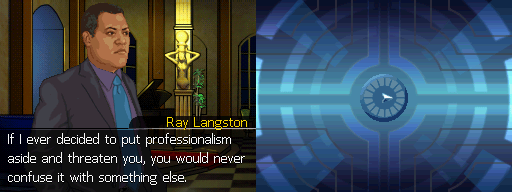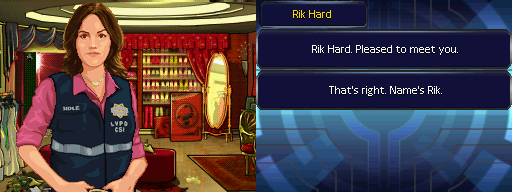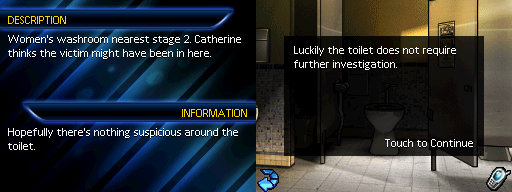This is another review of a Nintendo DS game, kind of following on from this one, the reasons for which are explained here. Normal service (i.e. reviews of old PC games) will be resumed shortly.
Such was my fondness for CSI: Deadly Intent – The Hidden Cases, I would have been happy for subsequent games in the series to change as little as possible, to the extent that simply providing more cases using the exact same engine would have done me just fine. Realistically, that was never going to happen, given that even the most positive of contemporary reviews didn’t come close to mirroring the almost bizarre levels of enthusiasm that I have for that game.
To be fair, though, Other Ocean’s follow-up, CSI: Unsolved! (hereafter Unsolved, because I really can’t handle quite so many exclamation marks in the same piece) is very, very similar to its predecessor in lots of ways. They’re very recognisably related, and follow much the same format. But certain presentational changes have been made, all well-intentioned and with the aim of improvement, and unfortunately they all add up to an altogether inferior experience.
Start the game and you’re straight into a DS rendition of the TV show’s credit sequence. And, yes, this finally (finally!) includes the theme song, although it’s a bit of a cruise-ship cover version. The cast of characters is pretty much the same as before, except Sara Sidle returns in place of the suddenly-departed Riley Adams (so, basically, the Season 10 cast). In TV, the point of a credits sequence is to introduce the actors who are going to be starring in the show. In a game without any voice acting, you just get a run-down of the character names (in a bizarrely pixellated font, in this case).
In a way, this credits sequence cuts to the core of what’s wrong with Unsolved. Last time we credited the developers for choosing a graphical approach that represented an interpretation of the characters, not the actors. Unsolved‘s opening indicates a reversal of that approach. The new character visuals are a lot more realistic, and an argument could easily be made that they’re an improvement on last time. Personally, though, I think something has been lost. The bold, primary-colours, comic-book feel of the previous game is gone, and the new visuals are rather washed out and grainy.
Flashbacks and case setups – so good in the last game – have taken a significant step backwards too. Again, it seems as if they’ve tried to bring these closer to the real TV show, but the technology’s not really up to it. While The Hidden Cases captured the spirit of the show’s look and feel in its own way, Unsolved goes for more of a straight copy – but the hardware isn’t really up to it. Everything about the setups is bad – from the cheap visuals and music, to the extremely silly sound effects (why they thought adding hammy arghs, screams and woo-hoos adds to anything, I don’t know). It’s such a shame because these sections were a real strength of The Hidden Cases and now they’re just sort of cheesy and embarrassing.
The mechanics of the game are almost exactly the same as before – you check out a scene, collect evidence, take it back to the lab, question suspects, and do it all two or three more times until the case is solved. Tap on some evidence, choose a tool to collect it, do a bit of a mini-game, quiz a perp, find out whodunnit. Some of the mini-games have changed a bit – the DNA matching one has been made much easier – but it’s all much the same, and provides just the right amount of low-level challenge to keep you briefly taxed but without disrupting the flow of the action too much.
There are some improvements and additions, although some are fairly pointless. There are more ‘red herring’ items, so not everything you click on is necessarily relevant, and you can marvel at having tapped on a chair to be told, “That’s a nice chair, but it doesn’t really relate to the case.” What about being THOROUGH when looking for EVIDENCE? What would Grissom say?
You also now have a few dialogue options during conversation, although it doesn’t really matter which one you choose as you’ll get the same response regardless. CSI is hardly a character driven franchise anyway, and there’s hardly any scope for developing the player character just by giving you a few choices over how to move the dialogue along. Still, at least – unlike the PC games – your character can talk and interact with the others instead of being a mute rookie.
And on that note, one of the more positive additions is a wider cast of lab techs: not, as in The Hidden Cases, just David Hodges, but also Wendy and Archie too. There’s still no Henry, and it would have been good to have a glimpse of ‘Super Dave’ in the morgue too, but still, it’s progress, and it all adds to the feeling that you’re in a busy lab working a case, in stark contrast to the ghostly abandoned feeling of the CSI sets in the PC games.
Interrogations also have a new dimension in that not every statement the suspects come out with can be disproved by evidence in your possession. It doesn’t exactly make the interrogations more challenging, but you do have to pay a bit more attention than before. Unfortunately, though, these sections have been made much longer, and lose much of the dynamism and dramatic tension that they previously had.
Also, the characters now have a greater variety of poses than before, so you’ll see them shift position as they are questioned. Hesitations and pauses show up in the dialogue text, and SHOUTING is CAPITALISED. You can clearly see the attempts to improve upon The Hidden Cases, but for me, again, the new poses only emphasise the cardboard cut-out nature of the characters, while the pauses and shouting just make it all seem a little bit silly.
The stories themselves aren’t particularly strong. On the positive side, you do get one more than in The Hidden Cases (5 instead of 4), and they are longer. However, they’re not particularly memorable – the death of a faded pop star and a reality show murder bookend some fairly mundane investigations, including one involving a CSI recreation club. To be honest I think the TV series was running out of ideas a little bit by this time, and that’s the feeling you get here. This was also the slightly bizarre period where Grissom had left, but married Sara Sidle, who then returned to the show, so there’s a nice shoehorned-in reference to Grissom when you work with her in the first case. There are occasional nods to the show’s history – there’s a moment when Brass alludes to his difficult relationship with his daughter Ellie – but like the show itself, the main focus is on the case rather than the characters.
Many of the suspects here are forgettable stereotypes, and despite having played through the game a handful of times I was unable to recall many of the pertinent details each time around, including the identity of the eventual killer. I suppose it meant repeat plays retained some element of surprise, but it’s not good that so few of the characters leave any kind of impression. Unlike some previous CSI games, there’s no link between the cases either, so when the final one ends – suddenly, and with a whimper – it doesn’t feel like time spent with the game has added up to all that much in terms of a final conclusion.
Other opinions are of course available, and some contemporary reviews of Other Ocean’s two CSI games put this one ahead of The Hidden Cases. I can sort of see why someone might consider Unsolved superior, given the additional length and clear efforts that have been made to improve the game. For me, though, not many of those attempts have been successful, and in particular the audio/visual changes are a real step backwards.
I suppose the best way I can put it is: it’s likely that, despite my unhinged enthusiastic ramblings here, most people aren’t going to be convinced to give The Hidden Cases a try. They probably have in their heads an idea what a CSI game on the DS might be like, and probably visualise a facile and rather silly touch screen game a long way removed from the TV show. Obviously, I don’t think that: I think The Hidden Cases is good – really good! But it is sort of what I think about Unsolved, for all its shared DNA (boom-tish!) with its predecessor. I’d still put Unsolved ahead of the PC lot, because of the clear linear structure that I think is a benefit for this kind of game, and the fact that you do actually feel like part of a cast of characters solving a case, but otherwise it’s a bit of a missed opportunity.
CSI: Unsolved! can be purchased for about £3 second hand. Screenshots, audio and video were captured via DesMume.






 Posts
Posts
My strongest memories of the PC game were calling someone into interrogation, realizing I didn’t have the necessary evidence, quietly excusing myself to return to the crime scene to examine everything more thoroughly, running the necessary tests, then returning to interrogation where the suspect has either:
A) been sitting the entire time.
B) gets called back to the police station roughly five times a day as I unlock a new question to desperately toss their way.
So when you say this is more linear, how do they handle that? A “Hey, I don’t think you’ve found everything here yet” message when you try to leave? Or can you still indiscriminately pester your suspects?
December 19, 2016 @ 11:09 pm
When searching a scene, there’s an icon in the corner that tells you whether you’ve found everything. So you fall into a pattern of searching a scene thoroughly, processing evidence which will all point towards suspect A, who is then called in for questioning.
Brass won’t let you talk to a suspect until you’ve processed everything, and you never have a choice of who you want to bring in. It’s search, process, oh we need to talk to this suspect, interrogation. Then either something will come out of the questioning, or your partner will find new information, which will open up a new location to search and then the whole thing is repeated.
I’m not saying it’s impossible to mess things up but I think you’d have to be wilfully ignoring the game’s attempts to guide you through this structure to do so. Whereas in the PC games you have more freedom but it just creates slightly daft situations where you blunder between scenes and suspects if you’ve missed something.
December 20, 2016 @ 5:43 am